Free Alternative to ChatPRD.ai
Explore five free AI tools that enhance productivity for product teams, automating tasks like report generation and feedback analysis.

Product operations teams often face repetitive tasks that take time away from larger goals. AI tools can help by automating tasks like creating reports, analyzing feedback, and drafting product documents. However, premium tools can be costly, so free options are crucial for budget-conscious teams.
Here are 5 free or budget-friendly AI tools to boost productivity without breaking the bank:
- BuildBetter.ai: Combines team communications and customer feedback into actionable insights. Paid plans start at $7.99/month; no free plan.
- Write My PRD: Automates creating product requirement documents (PRDs) and offers templates. Free plan available with limited features.
- AI Assist by airfocus: Simplifies feedback processing and drafts PRDs. Free trial available.
- ClickUp: Provides project management with AI-powered automation. Free plan includes basic features; AI tools require paid plans.
- Product Monkey: Converts design files to PRDs and engineering tickets. Free plan offers limited monthly usage.
Quick Comparison:
| Tool | Free Plan? | Key Features | Best For |
|---|---|---|---|
| BuildBetter.ai | No | Insights from team/customer data, reports | Teams needing data analysis |
| Write My PRD | Yes (Limited) | PRD creation, templates, skill coaching | Small teams/startups |
| AI Assist | Free Trial | Feedback analysis, document drafting | Teams testing AI tools |
| ClickUp | Yes (Limited) | Task automation, project management | Project-focused teams |
| Product Monkey | Yes (Limited) | Design-to-PRD automation, wireframe analysis | Design-heavy workflows |
Free tools like these can save time, improve efficiency, and reduce burnout for product teams. While free plans often have limitations, they’re a good starting point for exploring AI’s potential in product operations.
FREE: Complete Cursor AI Indepth Guide🤖 (Prompt Templates + 16 Page Doc) Best AI IDE - OpenAI o1 AI
1. BuildBetter.ai
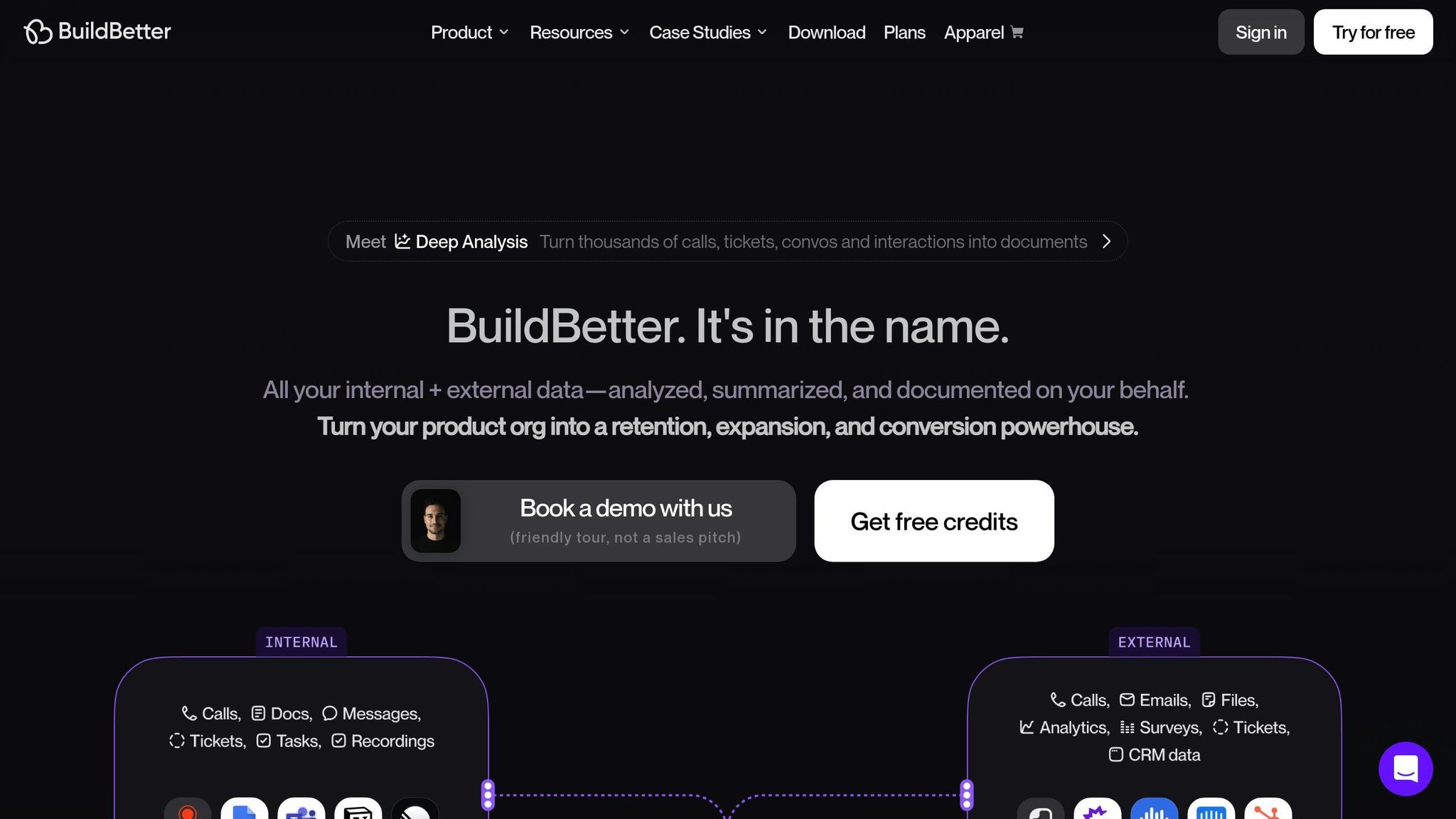
BuildBetter.ai is an AI-driven insights platform tailored for B2B product teams. Unlike tools that focus exclusively on external data, BuildBetter combines internal team communications with external customer feedback into a single, streamlined system.
Key AI Features for Product Teams
BuildBetter.ai addresses product operations challenges with three standout AI-powered capabilities. First, it transforms calls, tickets, and messages into instantly cited reports, eliminating the hassle of manually pulling together information from multiple sources. Its Signals feature turns every customer and team interaction into searchable insights, making it easier to spot trends and patterns.
The platform also includes an AI assistant that integrates with call records and internal knowledge, offering contextual support during product planning. Teams can run reusable workflows directly from their inbox, simplifying repetitive tasks like automating weekly updates or stakeholder reports. Additionally, BuildBetter provides high-quality summaries and custom document creation, ensuring consistent documentation across projects.
"It wouldn't be possible to do my job at this scale without BuildBetter." - John Strang, Product Operations
The platform significantly boosts productivity. Teams using BuildBetter have reported spending 43% more time on revenue-generating activities, saving around 18 hours per project (based on two-week sprints). This translates to approximately $21,000 in annual savings per person (assuming $45/hour) and reduces team meetings by about 26 per month.
Pricing and Free Plan Details
The Starter plan is priced at $7.99/month and includes unlimited seats. It offers 120 minutes (2 hours) of recording credits, 20 text threads, 1 report, 1 workflow, and 1 custom document. While it has fewer integrations, this plan is ideal for small teams needing essential functionality.
For additional usage, pay-as-you-go pricing applies: $0.10 per minute for recording time and $0.30 per thread for text processing.
Integrations with Popular Tools
BuildBetter.ai connects seamlessly with over 100 tools commonly used by product teams, such as Zoom, Microsoft Teams, Google Meet, Slack, Jira, Salesforce, Zendesk, HubSpot, and Intercom. It also offers a "no bot" option for sensitive meetings, ensuring privacy. These integrations allow BuildBetter to gather insights from across platforms, breaking down data silos and enabling informed product decisions.
Practical Applications for Product Teams
BuildBetter.ai is a game-changer for product teams needing to consolidate information from various sources. It’s especially useful for creating product requirement documents (PRDs), analyzing user research, and generating customer insight reports. By processing both internal and external feedback, it becomes an essential tool during the product discovery phase and for prioritizing features.
The platform’s value is reflected in its 98% subscription retention rate.
"We don't operate without BuildBetter. This is the only platform that we use religiously." - Aditya Goyal, Product Lead
2. Write My PRD
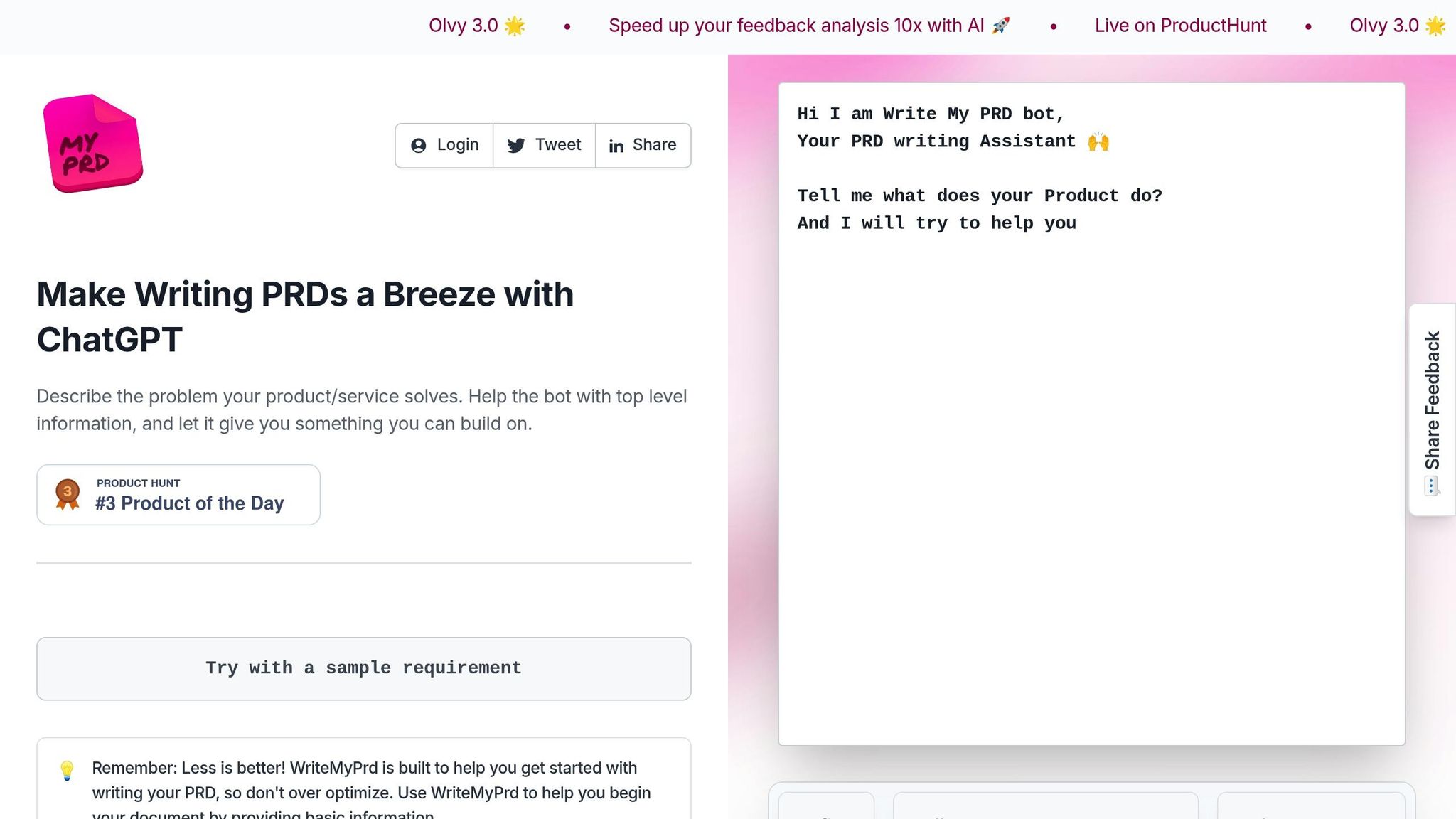
Write My PRD is an AI-powered assistant designed to simplify and speed up the process of creating product requirements documents (PRDs). By automating much of the heavy lifting, this tool allows product teams to focus on what truly matters - engaging with customers, collaborating with stakeholders, and refining prototypes - instead of getting caught up in lengthy documentation.
Core AI Features for Product Operations
Write My PRD is packed with features that tackle some of the most common challenges faced by product managers:
- Rapid PRD drafting: Quickly generates complete PRDs from simple ideas or outlines, saving significant time on initial drafts.
- Document analysis: Reviews existing PRDs and offers AI-based suggestions to improve clarity, structure, and completeness.
- Goal setting and metrics brainstorming: Assists product managers in defining clear objectives and measurable success criteria for their projects.
- PM skill coaching: Provides guidance on planning, communication, and documentation to help product managers sharpen their skills.
- Customized templates: Offers professionally designed formats for a variety of product documents, extending beyond PRDs.
"ChatPRD is amazing! Literally 3 prompts and 15 minutes, and I am ready to get feedback on something I would have agonized over for at least 2 hours." - SG, Principal Product Manager
These tools help teams produce professional, consistent, and actionable documents, ensuring that all stakeholders are on the same page.
Ideal Use Cases for Product Teams
Write My PRD shines in scenarios where clear communication and efficient documentation are critical. For product managers, it simplifies the process of outlining product requirements, reducing the chances of miscommunication during development.
Development teams benefit from the clarity and precision of AI-generated PRDs, which help align everyone on project goals and technical details. This reduces the need for back-and-forth discussions and streamlines execution.
Startups, in particular, find Write My PRD invaluable. Early-stage companies often lack the resources or experienced product managers necessary to produce polished PRDs. This tool bridges that gap, offering a structured approach to product development that ensures professionalism without requiring extensive expertise.
"I am loving ChatPRD to create PRDs quickly and identify holes in thinking. It's improved my PRDs and allowed me to output them faster but in a more thorough way." - Brad, Product Manager
Whether it's refining ideas with stakeholders, maintaining consistency across multiple projects, or rapidly iterating on product requirements, Write My PRD is an essential tool for teams working in fast-paced, agile environments. Its ability to turn basic concepts into detailed, actionable plans makes it a game-changer for modern product development.
3. AI Assist by airfocus
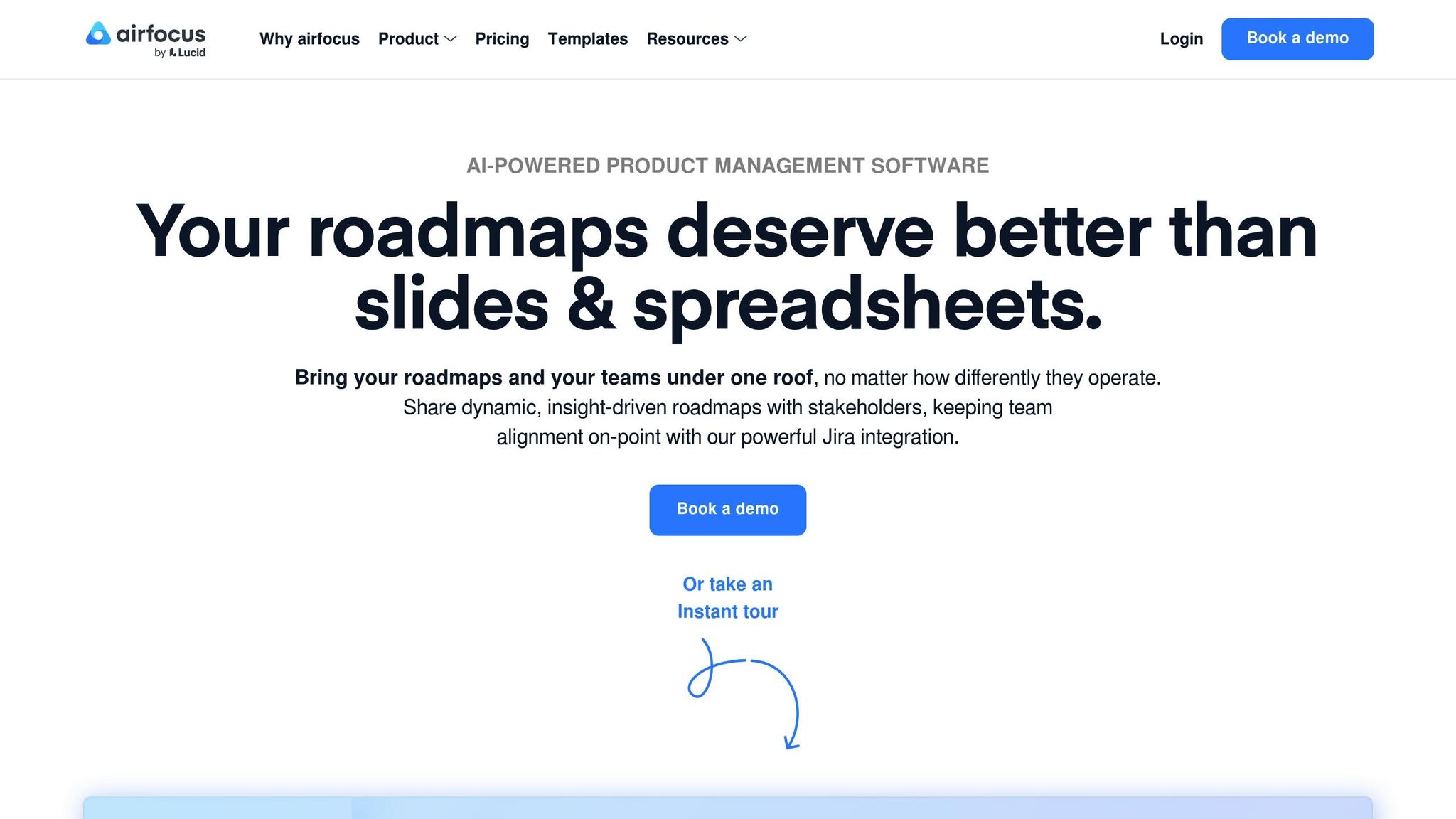
AI Assist by airfocus brings artificial intelligence directly into item descriptions and comments, making it a powerful tool for boosting productivity within the platform. By integrating AI where product teams do their work, this feature helps streamline processes and keeps the focus on strategic priorities.
Core AI Features for Product Operations
One of the standout features of AI Assist is its slash command functionality, which allows product managers to quickly generate initial drafts for documents like PRDs, user stories, and release notes. This feature also provides editing suggestions to refine and polish the output, saving time and effort.
Another key feature is sentiment analysis for feedback processing. Analyzing large volumes of customer feedback can be daunting, but AI Assist simplifies this process by categorizing feedback as positive, negative, or neutral. Paired with its summarization capabilities, the tool condenses lengthy feedback threads or meeting notes into concise, actionable insights. These features are a game-changer for teams looking to handle repetitive tasks more efficiently, giving product managers more time to focus on higher-level decision-making.
Free Plan Capabilities and Limits
AI Assist is available on a free trial basis, giving teams the chance to explore its capabilities before committing to a paid plan. Administrators can activate the free trial for existing teams, while enterprise teams can work with their customer success manager for access.
"Process feedback faster, improve product decisions, and streamline routine tasks with airfocus's purpose-built AI. Free to try."
This trial structure is particularly helpful for startups and smaller teams that need to carefully manage their budgets while still accessing advanced AI tools. It allows them to test the tool’s fit within their workflows without making an upfront financial commitment.
Integration with Popular Tools
AI Assist works seamlessly with popular tools like Jira, Trello, Azure DevOps, Asana, and Zapier. Its Microsoft Teams integration is especially useful, enabling teams to push feedback messages directly from Teams conversations into airfocus.
These integrations ensure that AI insights flow smoothly across your existing tools, enhancing current workflows rather than requiring teams to adopt entirely new systems.
Ideal Use Cases for Product Teams
AI Assist shines in scenarios where quick content generation and efficient feedback processing are critical. Product managers facing tight deadlines can use slash commands to draft initial versions of documents like requirements or release notes. Editing suggestions then help refine these drafts, reducing the time spent on early-stage writing without sacrificing quality.
For teams managing large volumes of customer feedback, the sentiment analysis and summarization features are particularly valuable. Instead of sifting through hundreds of support tickets or user reviews, product managers can quickly identify trends and extract meaningful insights to guide product decisions.
The tool also supports cross-functional collaboration by improving communication clarity. Technical teams receive clearer requirements, stakeholders get consistent updates, and the entire team benefits from standardized, AI-enhanced documentation. This makes AI Assist especially useful for teams that need professional-quality documentation but lack dedicated technical writing resources.
4. Producta
When it comes to streamlining product operations without breaking the bank, Producta brings a fresh perspective by focusing on aligning product strategy with stakeholder expectations. By combining tools for roadmapping, prioritization, and feedback management, Producta helps teams zero in on what truly matters and keeps everyone on the same page.
Key Features for Product Operations
One standout feature of Producta is its 360° feedback system, which collects input from customers, internal teams, and leadership. This feedback is then organized and prioritized to guide strategic decisions. The result? Product teams can align feature development more closely with user needs and business goals, ensuring their efforts deliver real value.
Integration with Popular Tools
Producta connects seamlessly with Jira and Slack, enabling teams to enhance their product management processes without disrupting their current workflows. That said, its integration options are somewhat limited compared to larger platforms. Teams with more complex tool stacks should evaluate whether Producta's available integrations can fully support their needs.
Ideal Use Cases for Product Teams
Producta shines for teams aiming to improve stakeholder alignment and establish a more structured approach to product strategy. It centralizes feedback into a single source of truth, making it a great choice for organizations transitioning from informal to more organized processes. However, if your team relies heavily on usability testing or in-depth qualitative research, you might find Producta lacking compared to more specialized tools.
5. ClickUp
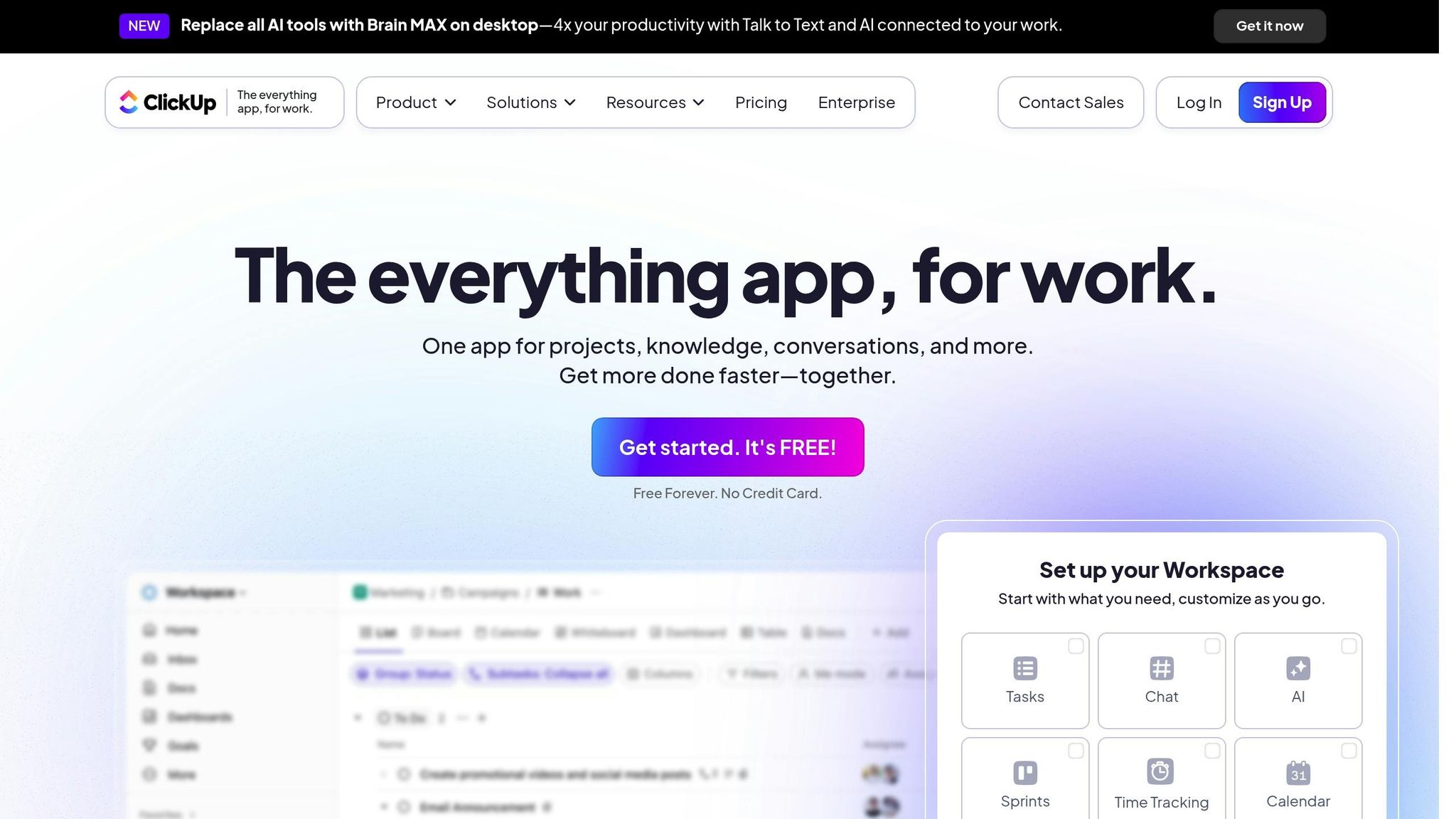
ClickUp brings AI into the world of project management, blending automation with actionable insights to streamline workflows. While many teams already use ClickUp for its core project management tools, the ClickUp Brain suite takes things further with advanced AI features tailored for product operations. These additions highlight the balance between functionality and limitations, especially for teams exploring free plans.
Core AI Features for Product Operations
The ClickUp Brain suite is designed to handle repetitive tasks, manage projects, and even generate meeting notes and reports, freeing up valuable time for teams. Its AI Agents can take over routine work, respond to queries, and execute commands without requiring manual input. Meanwhile, Autonomous Projects automatically assign tasks, monitor progress, and adjust priorities based on real-time data.
Other standout features include AI Meetings, which create notes, agendas, tasks, and summary reports, and Enterprise AI Search, which allows teams to quickly locate past decisions or feedback. ClickUp’s AI also analyzes workflows to pinpoint bottlenecks, recommend automation opportunities, and optimize resource allocation. This helps teams make smarter decisions about capacity planning and sprint management.
Teams using ClickUp Brain report impressive results, including an 86% reduction in costs, saving 1.1 days per week, and tripling task execution speed.
Free Plan Capabilities and Limits
ClickUp’s free plan offers a solid starting point with unlimited tasks, members, and collaboration tools like docs, whiteboards, Kanban boards, and sprint management.
However, the free plan has some notable constraints. Storage is capped at 60MB, which applies to attachments and video clips but not text or task data. Users are limited to 5 Spaces, with 40 Lists and 100 Folders per Space. Additionally, custom fields and advanced views like Gantt, Timeline, and Workload are restricted to 60 uses each. Most importantly, the AI-powered features, including ClickUp Brain, are only available on paid plans.
Integration with Popular Tools
ClickUp stands out with its ability to integrate with over 1,000 tools, solving a common challenge for product teams juggling multiple applications. Through native integrations, automatic imports, third-party connections, and an open API, ClickUp ensures seamless information sharing. For instance, teams using Microsoft Teams can receive instant notifications for comments, attachments, and status updates, along with rich link previews that include detailed descriptions.
These integrations not only streamline workflows but also save time. Teams typically reclaim over 5 hours each week by eliminating outdated knowledge management processes. By centralizing tasks and reducing manual data entry, ClickUp helps teams focus on what matters most.
Ideal Use Cases for Product Teams
ClickUp is a great fit for teams looking to consolidate their entire workflow into one platform. It combines project management, documentation, communication, and reporting in a single space. As Kateryna Sipakova, Portfolio Lead at Trinetix, puts it:
"We didn't want to adopt a new tool for one function and a different tool for another function. We wanted to have projects, internal operations, and goals all in one place. ClickUp has all of the functionality we wanted."
For teams that need strong project management tools paired with AI-driven automation, ClickUp is a powerful option. However, those focused on advanced AI features or detailed product requirements documentation should be aware that these capabilities are only available on paid plans. While ClickUp excels at consolidating workflows, upgrading beyond the free plan may be necessary to unlock its full potential.
6. Product Monkey
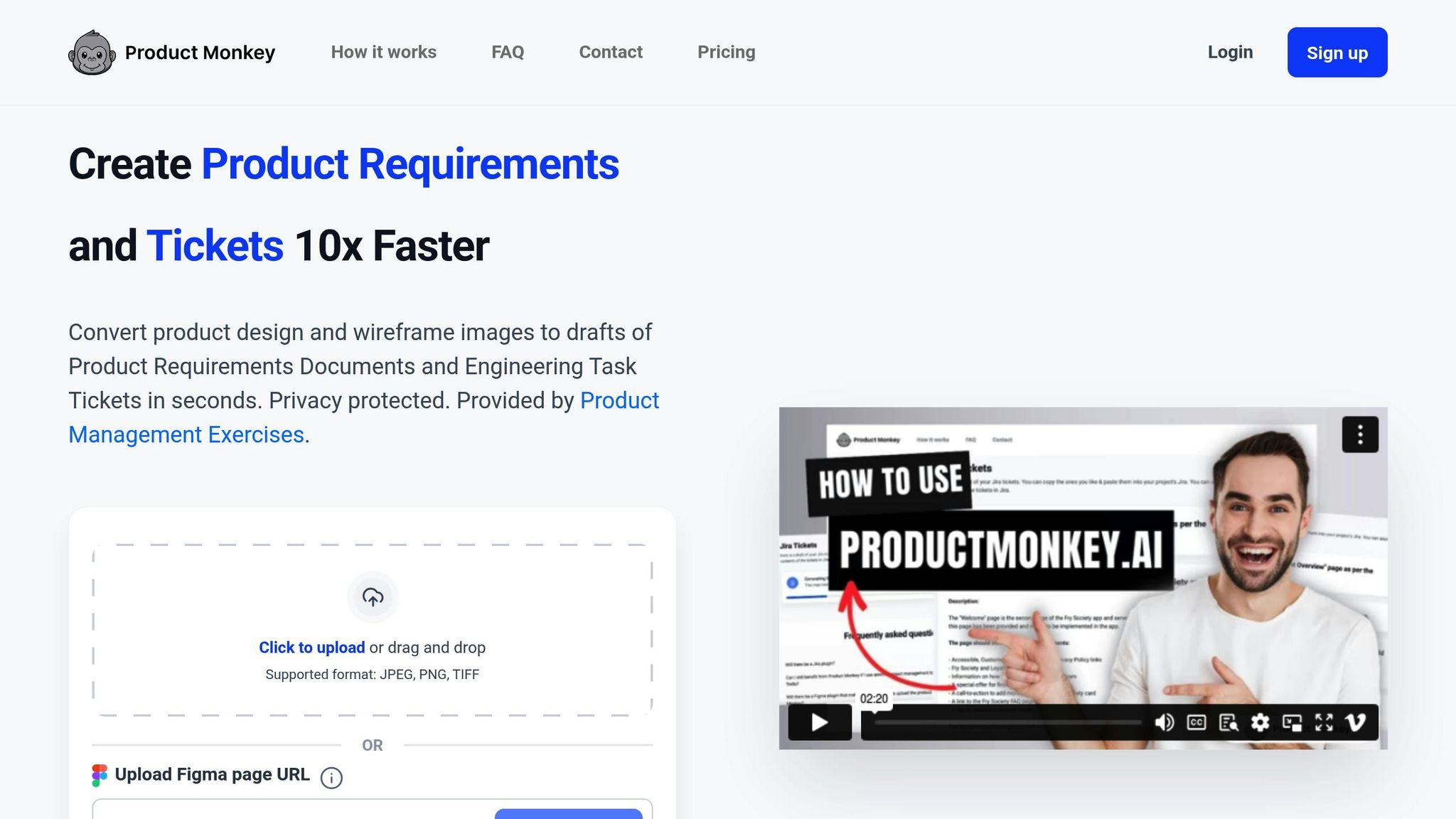
Product Monkey bridges the gap between design and development by transforming visual designs into actionable documentation. It specializes in converting wireframes and design files into Product Requirements Documents (PRDs) and Engineering Task Tickets (ETTs). For product managers juggling endless documentation, this tool offers an automated way to save time and streamline workflows.
Core AI Features for Product Operations
One of Product Monkey's standout features is its Natural Language Processing (NLP) capability. This AI-powered engine extracts key details from design images and wireframes, automatically generating PRDs and ETTs. These documents come complete with titles, detailed descriptions, acceptance criteria, user stories, and tags - all without the need for manual input. In fact, the platform claims to cut ticket-writing time by up to 80%.
Users have praised the tool for its efficiency. Bonnie S., Director of Product at Bitgo, shared:
"I'm surprised that it works this well."
To further enhance usability, Product Monkey provides customizable templates for PRDs and ETTs. These templates ensure consistent documentation while accommodating the specific needs of different organizations. Collaboration tools are also built in, allowing teams to review, comment on, and share documents seamlessly.
Free Plan Capabilities and Limits
For smaller teams or those testing the waters, Product Monkey offers a free plan that includes 20 tickets per month and 1 PRD per month. While this may not meet the demands of larger teams, it’s a great way for startups and individual product managers to experience the time-saving benefits before committing to a paid plan.
Integration with Popular Tools
Product Monkey integrates smoothly with popular project management platforms, making it easy to transfer generated content into tools like Jira, Linear, Asana, and Trello. For teams using Notion as their main documentation hub, the platform offers seamless integration. Design teams will appreciate its direct connection to Figma, eliminating the need for manual uploads. Plus, plugins for both Figma and Jira are currently in development.
Bijan Shahrokhi, Founder and CEO of Product Monkey AI, highlights the platform's mission:
"Product Monkey AI streamlines product management, allowing PMs to focus on strategy while automating tedious tasks. We're set to transform collaboration between product managers and engineering teams."
These integrations enhance workflows across design and development teams, enabling diverse use cases.
Ideal Use Cases for Product Teams
Product Monkey shines in design-heavy environments where wireframes and mockups are frequently produced. It’s particularly helpful during rapid prototyping or tight deadlines, as it transforms visual concepts into actionable engineering tasks. By automatically generating acceptance criteria and user stories, the tool reduces back-and-forth communication and ensures alignment across teams.
Lorenzo C., Growth PM at DTC Brands, summed it up perfectly:
"Wow it really works like magic."
For optimal results, upload high-resolution images with clear context and focus on one user flow at a time. This ensures the tool delivers precise, actionable outputs tailored to your team’s needs.
Tool Comparison Table
Selecting the right AI-powered product management tool can feel overwhelming. To simplify the decision-making process, the table below outlines two well-known options, focusing on their AI capabilities, integration options, pricing structures, and ideal use cases.
| Tool | Key AI Features | Integrations | Free Plan Limits | Best Use Cases |
|---|---|---|---|---|
| BuildBetter.ai | Call recording & transcription, AI chat using company data, automated project briefs, qualitative analysis | Zoom, Slack, Jira, Salesforce, HubSpot, Intercom, Microsoft Teams, Google Meet, Webex | No free plan (paid plans start at $7.99/month) | Teams needing comprehensive insights from internal communications and external feedback sources |
| ClickUp | Task automation, smart scheduling, AI writing assistant, project insights | 1,000+ integrations (e.g., Slack, Google Drive, Salesforce, GitHub, Zoom) | Free plan available with basic features | Teams seeking a cost-effective, feature-rich project management solution |
Each tool brings distinct advantages to the table. BuildBetter.ai excels at turning internal and external data into actionable insights, making it perfect for teams that prioritize in-depth qualitative analysis and collaboration. On the other hand, ClickUp stands out with its extensive free plan and wide range of integrations, offering a budget-friendly option for streamlined project management.
When choosing between these platforms, consider your team's specific workflow requirements. Both tools integrate effortlessly with popular communication and productivity platforms, ensuring your existing processes stay smooth and connected. This comparison provides a solid foundation for identifying the AI tool that aligns best with your product management strategy.
Conclusion
Free AI tools are transforming product operations by driving measurable productivity improvements - without the need for hefty investments. Research highlights that AI assistance can increase productivity by 14% while cutting handle time by 30%.
The tools explored in this article cater to diverse team requirements. Some excel at managing projects comprehensively, while others, like BuildBetter.ai, shine in turning scattered qualitative data from internal discussions and customer feedback into actionable insights.
While functionality is crucial, security cannot be overlooked. With 34% of data breaches stemming from internal actors and the average breach costing $4.88 million, evaluating the security credentials of AI tools is non-negotiable. Look for features like SOC 2 Type II, ISO 27001, and CSA STAR certifications, as well as role-based access controls to safeguard sensitive information.
Strong system integration is another critical factor. Seamless integration not only enhances operational efficiency but also reduces compliance costs - by as much as 50% - and boosts overall efficiency by 40%.
Beyond the technical aspects, there’s an important human element to consider:
"AI is a powerful tool, but it's the product manager's insight, creativity, and strategic thinking that will ultimately drive the creation of successful products. Embrace AI as your collaborative partner in building better products and delivering exceptional user experiences."
– HelloPM
To start, consider running a pilot project. Document crucial prompts and workflows while fostering collaboration across teams. As we've seen, integrating AI simplifies workflows and frees up teams to focus on strategic priorities. The real success, however, lies in combining automated insights with human expertise, ensuring a user-first approach to product development.
FAQs
What are the advantages of using free AI tools for product operations, and how do they differ from paid options?
Free AI tools bring a lot to the table for product operations teams, especially when it comes to boosting efficiency, simplifying workflows, and automating repetitive tasks - all without stretching your budget. These tools can empower teams to make better decisions with data and uncover insights that are ready to act on. This makes them particularly helpful for startups or teams working with limited resources.
While paid tools often come with advanced features or dedicated support, free options are a fantastic way to improve productivity without extra costs. They offer an easy and accessible way to refine product management processes and strengthen team collaboration, allowing teams to focus on delivering results without financial concerns.
What’s the best way for teams to choose a free AI tool for product management?
To pick the best free AI tool for product management, start by pinpointing what your team needs most - whether it's roadmapping, analyzing customer feedback, or organizing product documentation. Once you've nailed down your priorities, dive into testing different tools to find the ones that truly fit your workflow and offer meaningful benefits.
Look for tools that are easy to use, work smoothly with your current processes, and tackle your team's specific challenges. Spending some time experimenting with a few options can make all the difference in finding the right match.
What challenges can arise when using free AI tools for product operations, and how can teams address them?
Free AI tools come with their fair share of challenges. Things like usage limits, restricted customer support, and occasional inaccuracies can throw a wrench into workflows or result in less dependable outcomes. Plus, integrating these tools often demands extra effort, and there's always the risk of biases creeping in, which could impact the quality of your product.
To tackle these hurdles, it's important for teams to choose tools that align closely with their specific needs. Thorough testing is essential to uncover and address any potential biases, and having human oversight ensures that AI-generated outputs are accurate and reliable. This balanced approach helps keep operations effective while preserving both accuracy and creativity.